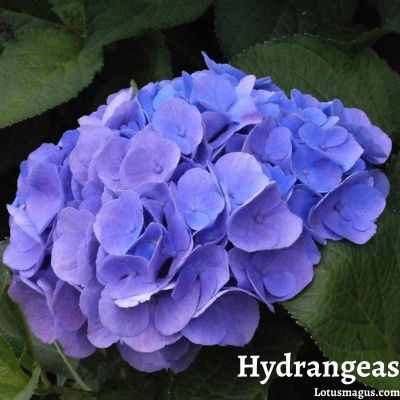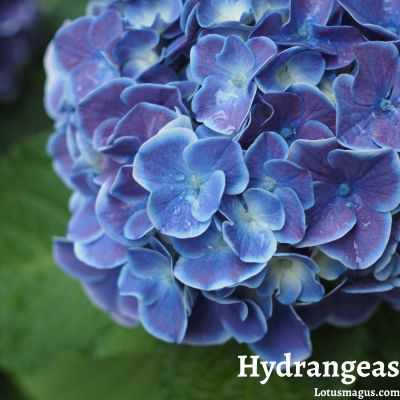Every garden would benefit from having hydrangeas, but pruning them may be challenging. In order to ensure healthy growth and brilliant blooms, you must be aware of when and how to trim your hydrangeas. Everything you need to know about pruning hydrangeas, including when, how, and what equipment to use, will be covered in this article.
Why Prune Your Hydrangeas?
Hydrangeas must be pruned in order to remain healthy and attractive. You can encourage new growth and stop the spread of illness by getting rid of dead or unhealthy wood. Pruning aids in shaping the plant and gives it a more aesthetically pleasing and consistent look.
When to Prune Hydrangeas
The kind of hydrangea you have will determine when to prune it. Hydrangeas come in two primary varieties: those that flower on old wood and those that flower on fresh wood.
Hydrangeas that Bloom on Old Wood
Bigleaf (Hydrangea macrophylla) and oakleaf (Hydrangea quercifolia) hydrangeas, as well as other varieties that bloom on old wood, should be clipped as soon as their blooming period is through. This is because shortly after the present flowers have gone, the flower buds for the next year will start to grow. These buds will be removed by pruning later in the growing season, which will reduce or eliminate blooms the next year.
Hydrangeas that Bloom on New Wood
Hydrangeas like panicle (Hydrangea paniculata) and smooth (Hydrangea arborescens) hydrangeas, which bloom on new wood, may be clipped safely in late autumn after the plants have gone dormant or in early spring before new growth begins. There is no chance of damaging the flower buds if you prune in the autumn or spring since the flower buds for the next year won’t grow until late spring of the same year they bloom.

How to Prune Hydrangeas
It’s time to learn how to trim your hydrangeas now that you know when to do so. Using only a few simple instruments, the procedure is rather easy to do.
Tools You’ll Need
- Pruning scissors To make clean cuts and stop the spread of illness, use sharp, well cleaned pruning shears.
- Loppers: For thicker branches that are too big for pruning shears, use loppers.
- Gloves: Cover your hands with gloves to prevent wounds and thorns.

Steps for Pruning Hydrangeas
- Determine the dead or ill wood: Search for branches that are brittle, brown, or diseased-looking. In order to encourage new development and stop the spread of illness, these branches should be cut off.
- Employ pruning shears or loppers to get rid of any dead or diseased wood that may be present. Make a precise cut as near as you can to the branch’s root.
- Check for any branches that are crossing or rubbing against one another, and remove them. These branches need to be cut off since they might harm one another.
- To encourage strong development and ventilation, thin down the plant by removing any weak or flimsy branches.
- Shape the plant: To give the plant a more aesthetically pleasing and consistent look, use pruning shears.
What is the best month to prune hydrangeas?
Panicle hydrangeas should be pruned in late winter or early spring, according to a recent article on Homes & Gardens. Moreover, this is an excellent time to cut any stems that are weak or dead. Yet some hydrangea varieties, including bigleaf hydrangeas, should be clipped as soon as summer blooming ends, but no later than August 1. Hydrangeas shouldn’t be pruned in the autumn, winter, or spring since doing so might harm the plant and prevent it from blossoming.
The Spruce article provides some extra hydrangea trimming advice. Trim away spent blooms as they wilt to keep the plant looking neat. Pruning should be done after the majority of the blossoms have faded. Start by removing stems that are obviously dead or frail. Don’t remove all the old wood, either, since this is what will continue to blossom as the new growth develops.
If your hydrangea needs to be pruned because it has outgrown its container, you may do it by removing a few branches to reduce its size. Save some healthy branches to prevent losing all the blooms when you prune away some branches to the ground or to a main stem. Bigleaf hydrangeas may be trimmed to one-third of their original size, but harsher pruning methods can weaken the shrub and make it languish for a season or two.
What happens if you don’t prune hydrangeas?
Although some hydrangea varieties need regular trimming, others grow best without it. Hydrangeas that bloom on old wood will actually bloom more abundantly the next season if you don’t trim them. Nonetheless, it’s wise to carefully thin or deadhead them as necessary. But remember that any new growth that arises after trimming won’t blossom the following season.
Hydrangeas that bloom on old wood might ultimately turn into a tangled jumble of woody stalks if you don’t trim them, and the blooms will become smaller and less beautiful. Moreover, lack of trimming is often the cause of your hydrangeas’ failure to bloom. To prevent harming your hydrangeas and to make sure they continue to bloom wonderfully, it’s crucial to know when to trim them.
According to Homes & Gardens, bigleaf hydrangeas should be clipped as soon as the summer blooming season ends but before August 1 whereas panicle hydrangeas should be pruned in late winter or early spring. The Spruce advises starting the trimming process once the majority of the blossoms have faded. Start by removing any stems that are obviously weak or dead, but avoid removing all the old wood since it will continue to blossom as the new growth grows.
You may remove some branches from your hydrangea if you need to trim it to limit its size. But keep some strong branches to prevent losing all the blossoms. A bigleaf hydrangea may be pruned down to one-third of its original bulk, but harder trimming can weaken the shrub and make it languish for a season or two.
Do hydrangeas need to be cut back for winter?

Pruning your hydrangeas correctly is essential to ensuring that they bloom and survive, even in the winter.
There are two types of hydrangeas: old-growth bloomers and new-growth bloomers. Bigleaf hydrangeas and other old-growth bloomers shouldn’t be clipped in the winter since they produce flowers on “old wood,” or the growth from the previous year. Since they will bloom more prolifically if left alone, these hydrangeas should only get minor pruning, if any at all. Old-growth bloomers may lose prospective blooms for the next growing season if they are pruned.
Pruning should be done in the late winter before new growth starts on new-growth bloomers like panicle and smooth hydrangeas since they bloom on new wood. With this kind of trimming, the plant will produce new growth and blossom the next season. The stems of new-growth bloomers must be pruned down to a length of around two feet. This will promote the development of new branches, resulting in a fuller, healthier plant.
It is crucial to remember that trimming hydrangeas excessively, prematurely, or late might harm their health and development. Reduced blooming or even plant mortality might occur as a consequence of excessive trimming or pruning at the incorrect time. Always do your study on the particular kind of hydrangea you have and prune according to the instructions provided.
You may take additional actions to take care of your hydrangeas over the winter in addition to trimming. The plants may be helped to survive the winter by being shielded from the chilly winds and temperatures, receiving enough water, and having the base of the plant mulched.
Also Read : When to Cut Back Hydrangeas for Winter: A Comprehensive Guide
How far down do you prune hydrangeas?
Depending on the variety of hydrangea and the desired outcomes, hydrangea pruning may be done in the autumn, late winter, or spring. A heading cut, which reduces stems to just above a plump bud to encourage new growth, is a common technique for pruning hydrangeas.
Wait until late winter or early spring to trim panicle hydrangeas with conical-shaped bloom heads that provide wonderful winter interest to your garden. Cutting the stems to a height of 18 to 24 inches can also help prevent flopping by creating a strong foundation for fresh growth.
Pruning has to be done at various periods of the year for other varieties of hydrangeas. Old-wood blooming hydrangeas need to be pruned shortly after the summer blooms have faded, while new-wood blooming hydrangeas should be pruned in late January before new growth starts. Cutting all the branches down to about a foot above the ground in late winter or early spring may help revitalize a spindly hydrangea.
Make your cuts immediately above a group of huge, healthy leaves when trimming hydrangeas. A branch may be totally removed if it is dead or damaged. A plant’s development might be stunted or even prevented from blossoming if you prune it too much. It may be challenging to prune hydrangeas, but with the appropriate time and methods, you can encourage your bushes to flourish and provide lovely flowers year after year.
Should hydrangeas be cut back every year?
The sort of hydrangea you have will determine the response.
Avoid trimming hydrangeas in the autumn or winter if they bloom on old wood, such as bigleaf hydrangeas (Hydrangea macrophylla) and mountain hydrangeas (Hydrangea serrata). When they have done flowering in the summer, old wood hydrangeas need to be clipped. These hydrangeas form their buds on the growth from the previous year, thus trimming them too late risks losing the flowers for the next year. So, it is advisable to trim old wood hydrangeas as soon as the summer blooming is through, but no later than August 1.
On the other hand, you may trim hydrangeas that bloom on new wood in late autumn or early spring before new growth starts, such as panicle hydrangeas (Hydrangea paniculata) and smooth hydrangeas (Hydrangea arborescens). These hydrangeas form their buds on the growth of the current year, thus trimming them in the autumn or early spring won’t have an impact on their blooms the following year.
Pruning these bushes annually not only encourages hydrangeas to produce more blooms but also keeps them healthy if they sustain weather-related damage and enables you to shape them whatever you choose. The optimal time to prune hydrangeas is in the autumn, late winter, or spring when stems are cut back to just above a big bud, known as a heading cut. Wait until late winter or spring to trim these plants since their conical bloom heads provide wonderful winter flair to your garden.
Should you trim off dead hydrangea blooms?
Indeed, deadheading your hydrangeas may in fact help the plants in a number of ways.
Hydrangeas’ spent flowers are removed from the plant when you deadhead them. The blooming shrubs respond to this by ceasing to produce seeds and focusing all of their energy on growing roots and leaves instead. You may assist your hydrangeas in gaining strength and health by doing this. Also, by encouraging hydrangeas to grow additional blossoms, deadheading may improve the aesthetics of your yard.
The initial set of flowers on your plants should start to turn brown and dry at this point, since this is the ideal time to deadhead hydrangeas. Cut the stem above the first set of healthy leaves and underneath the flower head using a pair of sharp pruning shears. Be careful to cut the plant cleanly so as not to harm the remaining parts.
During the flowering season, you may deadhead the bushes, but you should stop about mid to late November. This is necessary for the plant to continue flowering in order to produce buds for blooms the next year. If you deadhead too late in the season, you risk losing these buds and having fewer blooms the next year.
Is Miracle Grow good for hydrangeas?
Hydrangeas may be grown without fertilizer, but they will benefit from the added nutrients that fertilizers like Miracle-Gro give.
While applying Miracle-Gro on hydrangeas, it’s crucial to bear in mind that they need slightly acidic soil with a pH level between 5.2 and 5.5. Fortunately, Miracle-Gro has products designed specifically for plants that love acid, like hydrangeas, such their Miracid plant food. This water-soluble fertilizer works well for plants that thrive in acidic soil and may be used to encourage hydrangeas to produce lush foliage and stunning flowers.
To prevent overfertilization while applying Miracle-Gro on hydrangeas, it’s crucial to carefully follow the directions. Typically, you should fertilize hydrangeas every four to six weeks from spring through autumn, when they are actively developing. In general, hydrangeas don’t need fertilizer throughout the winter.
There are other things you can do to encourage healthy development in hydrangeas besides utilizing fertilizer. For instance, adding organic stuff like compost or manure might help the local soil. This will aid in enhancing the nutritional content, drainage, and soil structure. To assist keep moisture in the soil and prevent weed development, you may also mulch the area surrounding the base of hydrangeas.
Hydrangea care and maintenance

While hydrangeas need only little maintenance and careful pruning to achieve their greatest blooming. By removing dead or infected wood, pruning aids in controlling the size and form of the plant and promotes vigorous new growth and blooming.
Depending on the sort of plant you have and when it blooms, you should trim hydrangeas at the ideal moment. Both new wood and old wood may blossom on hydrangeas, and each demands a distinct pruning strategy. Pruning may be done safely on hydrangeas that bloom on new wood, like the panicle variety, in late autumn after the plant has gone dormant or in early spring before new growth starts. Contrarily, bigleaf or oakleaf hydrangeas, which bloom on old wood, should be clipped in late winter or early spring, just before new growth starts.
To prevent harming the plant, it is crucial to prune using clean, sharp instruments. To promote new growth, head back stems to just above a plump bud (this is referred known as a heading cut). Cut all the branches down to a foot or so above the ground in late winter or early spring if you need to severely prune a spindly shrub. When the new growth grows, the old wood will continue to blossom, thus it is crucial to avoid overpruning it.
Also, because hydrangeas have bloom heads with a conical form that provide attractive winter interest to your landscape, it is preferable to avoid cutting them in the autumn. To keep the plant appearing neat, wasted blossoms may be removed as they deteriorate. Just use bypass pruners to remove the blossoms. If your hydrangea has to be pruned because it has exceeded its place, you may remove some branches to reduce its size, but save some healthy branches to prevent losing all the blooms.
Conclusion
While hydrangea pruning might seem overwhelming, with the correct equipment and training, it’s a straightforward procedure that can support strong growth and colorful flowers. To stop the spread of illness, don’t forget to trim your hydrangeas according to the sort of blooms they produce and to use clean, sharp equipment. You may trim your hydrangeas like an expert and take pleasure in their beauty for many years with a little practice.
FAQs
- Can I prune my hydrangeas in the summer?
Pruning hydrangeas in the summer is best avoided since it might eliminate the bloom buds for the next year. It is advised to prune hydrangeas in the late autumn or early spring.
- What happens if I don’t prune my hydrangeas?
Your hydrangeas risk becoming overgrown and losing their form if you don’t trim them. Moreover, this may result in a reduction in airflow and a rise in illness risk.
- Can I prune my hydrangeas if they haven’t bloomed?
Hold off on trimming if your hydrangeas haven’t flowered until you know if they bloom on old or fresh wood. When pruning is done improperly, flower buds for the next year may be lost, leaving little or no blossoms.
- Can I use hedge trimmers to prune my hydrangeas?
Hedge trimmers shouldn’t be used to prune hydrangeas since they could harm the plant and make them seem uneven. For the greatest results, it is recommended to use tidy, sharp pruning shears.
- How often should I prune my hydrangeas?
Once a year, either just after they stop flowering (for those that bloom on old wood) or in late autumn or early spring, hydrangeas should be clipped (for those that bloom on new wood). Overpruning may make a plant weaker and cause less flowering.
- How much should I prune my hydrangeas?
Your hydrangeas’ size and growth patterns will determine how much trimming is necessary. Generally speaking, while pruning, you should try to remove no more than one-third of the plant’s total size.
- Can I prune my hydrangeas to a specific shape?
You may trim your hydrangeas to give them a certain form, such a square or circle. To prevent weakening the plant, it’s crucial to avoid over-pruning or removing excessive amounts of leaves.
- Can I prune my hydrangeas in the rain?
Pruning hydrangeas in the rain should be avoided since it increases the danger of disease. When it’s dry out, wait to trim your plants.
- Can I use pruning sealant on my hydrangeas?
Sealant pruning is not essential for hydrangeas and may even slow recuperation. The plant should be allowed to recover naturally rather than applying sealant.
- How do I know if I’ve pruned my hydrangeas correctly?
The next year, if your hydrangeas were properly trimmed, you should see strong new growth and colorful flowers. Reevaluate your pruning methods if you observe any problems, such as diminished flowering or disease symptoms.
Related Post:
Pruning Hydrangeas in Spring : Should I? Tips and Techniques
